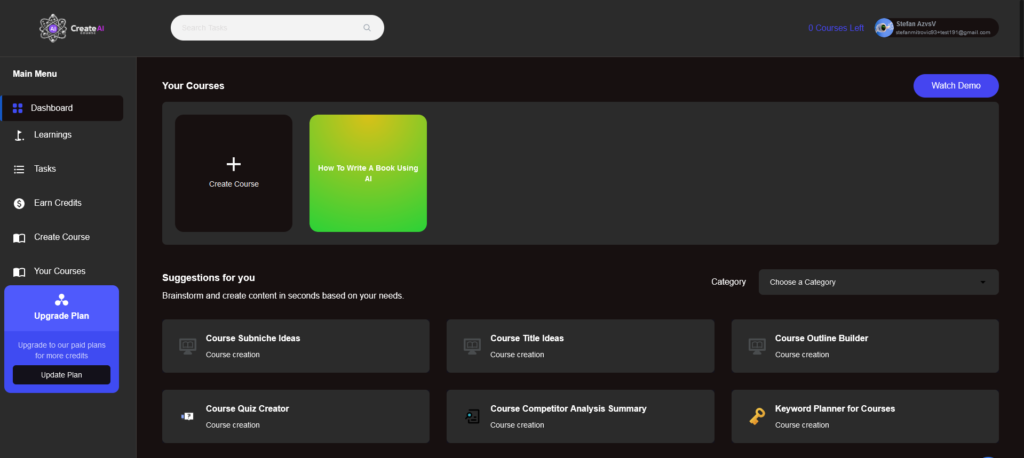Is selling online courses profitable is a question many are asking as online education becomes more popular. Creating and selling courses online offers a unique opportunity to generate income while sharing your expertise.
Online courses can be incredibly rewarding if you choose the right topic, create valuable content, and do good marketing. This approach not only benefits learners but can also provide a steady income for creators.
Understanding the market, choosing profitable topics, and engaging with your audience are key components to succeeding in the competitive world of online education. Let’s explore how you can make the most of this opportunity.
Is Selling Online Courses Profitable?

Yes, selling online courses can definitely be profitable.
Think about it: we’re living in a time where people crave knowledge and convenience equally.
Online courses offer both – you get to learn at your own pace, from wherever you like and whenever you like. And then, there’s the obvious part where you get the knowledge if you want it.
Now, this isn’t just good for learners, but it is also great for people who have the knowledge.
If you are one of those people who always wanted to teach something but for one reason or the other never got around to it, creating, and more importantly – selling, and online course is a perfect thing for you for more than one reason.
The beauty of online courses is that once you’ve created and set up your course, you can sell it repeatedly without much additional cost.
This can lead to a significant income over time, especially as you scale up your offerings and reach more people.
Many regular people with knowledge in one field, whatever that might be, have turned into course creators and turned their expertise into substantial income, and in some cases, it’s even replaced their full-time jobs.
What a dream, huh?
However, it’s not just about throwing a bunch of videos online. The key to “making it” lies in several factors.
First, you’ve got to nail the content – make it valuable, engaging, and unique. Then there’s the pricing strategy, which needs to reflect the value you’re offering without scaring off potential learners.
Next, there’s the marketing – not my favorite part, I have to admit!
It’s all about getting your course in front of the right eyes. Utilize social media, email newsletters, and even content marketing on your blog or YouTube channel to draw attention to your courses.
Lastly, let’s not forget about feedback. Always be tuning into what your students are saying. Their feedback can not only help you improve your existing courses but also inspire new ones.
This cycle of creating, marketing, selling, and refining is where the real profit in online courses lies.
In a nutshell, while it’s not a guaranteed get-rich-quick scheme, selling online courses is definitely a viable way to generate income—if you’re willing to put in the work.
How Much Money Can You Make Selling Online Courses?

What you can earn from selling online courses can vary dramatically, and it’ll depend on things like your course topic, the demand for that topic, how well you market your course, and, of course, how many students enroll.
However, to give you a concrete idea, let’s talk numbers:
- Beginners or side hustlers: If you’re just starting out or treating course selling as a side gig, you might earn between $5,000 to $25,000 a year. This is common for those who are still building their audience or are only dedicating part-time efforts.
- Established creators: Then, if you progress further and make selling online courses an important part of your job, your earnings can increase to $40,000 to $120,000 annually, easy. This is, of course, possible when you build a solid audience base and develop your marketing.
- Full-time professionals: At the top end, for those whose main business is online courses, earnings can shoot from $40,000 to millions of dollars each year. Yes, you read that right—millions! This tier is for those who’ve managed to scale their offerings and perhaps sell high-ticket courses to a large, engaged audience.
Now, let’s break down potential earnings by pricing scenarios:
- Low-end courses: If you have a mini-course priced at $50 and you enroll about 10 students each month, you’re looking at $500 per month or $6,000 per year. This is more typical for those just getting their feet wet.
- Mid-range courses: If your course costs $200 and you attract 50 students each month, your monthly income could be $10,000, summing up to $120,000 a year. This level of success usually comes with some established credibility and a decent-sized audience.
- High-end courses: For a premium course priced at $500 with 100 monthly enrollments, your monthly earnings would be a whopping $50,000, which translates to $600,000 annually.
- Super successful courses: Then there are the stars of the show, creators who might sell a $1,000 course to 1,000 students a year, raking in a million dollars. This level of success is exceptional and involves a combination of expertise, reputation, and effective sales strategies.
These examples show that online courses can be anything from a nice side income to a major revenue stream, depending on how much you’re willing to invest in terms of time, effort, and strategy.
Keep in mind, the road to these earnings is paved with hard work in content creation, course updating, marketing, and student engagement.
How To Monetize Online Courses
Monetizing online courses is all about figuring out how to make money from the knowledge you’re eager to share. Let’s look at some effective ways you can turn your courses into cash.
1. Direct Sales
The most direct way to earn from your courses is simply to sell access to them. You can do this through your own website or by using platforms like Udemy or Teachable.
You simply sell lifetime access to your course, one time, and then people can learn when, where and however fast or slow they like.
Setting a price that reflects the value of your course is key, naturally. You don’t want to overprice a simple course, but you don’t want to underprice yourself either.
The price you set for your course should reflect the amount of work you put into it, the amount of work you put into acquiring the knowledge, the request for this kind of the course on the market, and other similar factors.
2. Subscription Model
Think about Netflix. You pay a monthly fee and get unlimited access to a lot of content.
You can apply the same model to your courses.
This method is often used for selling access to tools and software, but if you constantly add new content, lessons and any other type of value to your courses, you can use this method as well.
It encourages a steady stream of income and can be more appealing to students who prefer accessing multiple courses under one fee. Or course, if you have more than one course to offer.
If not, you’ll get there with time.
3. Freemium Model
Here’s where you can get creative. Offer some of your course content for free to draw students in, then charge for the more advanced or detailed sections.
This approach allows potential customers to test out your material and see if it’s the right fit before they commit to a purchase.
The key here is to trigger their imagination and give them enough value to make your (potential) students want to learn more, but not give away too much.
To say it simply, to make this type of offer pay off, you have to find the right balance.
By mixing and matching these (and even some more) strategies, you can find the best way to monetize your online courses that suits your style and meets your financial goals.
How to Maximize Your Earnings

To maximize your earnings from online courses you have to do much more than just create content and wait for students to enroll.
You have to set the right price, market effectively, and continuously improve what you offer. Here’s a closer look at how you can increase your course earnings.
Pick the Right Price
Pricing can make or break your course. It’s not just about slapping a price tag on it, but you actually have to figure out what your students will really get out of it and how much that’s worth.
Are they learning something that could bump up their career? Or is it more about a hobby?
Usually, you can charge more for professional skills than for leisure learning.
To take things even further, don’t just guess—look around at what others are charging for similar stuff. You want to be in the ballpark but still show that your course has its own special sauce.
Really Get to Know Your Audience
Before you set your price in stone, see what your potential students think about it. Throw out a survey, check out what your competitors are charging, and maybe test a few different prices.
This helps you hit that sweet spot where people feel like they’re getting their money’s worth without breaking the bank.
Get the Word Out
Alright, you’ve got a killer course—now make sure people know about it!
Use social media, blogs, or even podcasts to talk about what you’re teaching. And don’t forget about email.
Keep your students posted with updates and sneak peeks of your course content. We already talked about Freemium model for your course, so promoting that over social media or newsletter is also a great option for getting new eyes on your product.
Keep Your Content Fresh
Nobody wants to pay for outdated stuff. Keep your course fresh with the latest info, and tweak things here and there based on feedback from your students. This keeps them coming back for more and tells new students that you’re serious about quality.
Offer More to Buy
Here’s where you can make some real cash. If someone’s already bought your course, why not offer them something else? Maybe a more advanced course, or a special one-on-one session with you. It’s easier to sell to someone who’s already digging what you offer.
Some of you might be familiar with this as I like to say it quite often but – think about those trinkets at a supermarket checkout. Once there, you are more likely to buy something more, right?
Same thing with your business. If you already have their attention, offer even more value.
Partner Up
Think about teaming up with someone who can help spread the word. Maybe there’s a blogger out there who shares your vibe, or a company that could use your course for their employees. This gets your course in front of more eyeballs without you having to do all the legwork.
By keeping things real and focusing on what your students need, you can bump up your earnings and have a blast teaching what you love.
Why Sell Online Courses?
Selling online courses is a fantastic way to share your knowledge and passions while also making some decent money. But there’s more to it than just the cash. Here’s why getting into the online course game could be a smart move:
High Demand And Flexibility of Online Learning
The thing is, people want to learn what the learning experience is available and approachable.
That’s why online courses are a great way for people everywhere to learn. You don’t have to be in the same place as your teacher, you don’t have to actually go to classes that are set in a time different than when you were available, and so on.
On the other hand, for teachers this means that they can reach far wider audience than they ever could in person. They would be tied geographically to teach only people in their close proximity.
The number of people who can attend would also be limited, and so would the number of lessons a person can give.
With online courses, none of this exists, and you can have as many students as are interested in your work, almost anywhere in the world, and you can give as many lessons as you have students, again and again.
Low Starting Costs
When you think about it, all you need to start earning with online courses is your knowledge and your computer and phone.
Your fist course doesn’t have to be perfect, you don’t have to film it in a studio or have professional camera, microphone and high-end editors.
Sure, you can, if you want, but that is not a necessity. People come to learn and they don’t much care for the quality as long as they can clearly hear and see what you have to show.
At the same time, the chances for earning are much higher than what you invest, so there’s notehr win in that.
Keep Learning
Teaching others also forces you to stay on top of your game. To teach well, you need to keep learning and updating your skills. This means you’re always growing, both personally and professionally.
You start with something you already know and want to share with the world, no matter if it’s your killer coding skills, yoga moves, or a knack for cooking Italian food.
But you always have to improve that and learn even more if you want your course to grow.
And if you’re a real altruist, you will surely enjoy knowing that you’re helping others learn and be better themselves.
Profitable Online Course Ideas
Maybe the most important thing about making courses is choosing the right topic.
If you have one topic that you’re really knowledgeable in, than you should definitely go with it, but if you have more passions, or if you’re ready to learn new things for your course, there definitely are some things that you want to give more attention to.
Choosing evergreen topic is always a good choice. For example:
- Health and wellness
- Tech skills
- Business
- Healthy living
- Wealth
- Personal improvement and development
- Languages
- Parenting
Creating Your Online Course with CAIC

If all of this sound attractive to you and you want to try a hand at selling online courses, but you don’t really have time, ideas, or a special skill you want to share, there’s CAIC to help you out with that.
Let’s start with the case where you don’t know where to start from. CAIC has an option to help you do a research of the market and give you niche ideas for what you can create a course on.
Besides that, it can help you choose title for your course, create ideal buyer persona for better marketing efforts, and so on.
Then, the most important part is that you can create the whole course in one single click.
First, the tool will create the complete outline for your course that you can further improve and edit if you wish, and then just click a single button, and the tool will create the whole course, together with a PPT presentation and audio version of your course.
Furthermore, the tool can help you create newsletter plan, social media plan, and altogether marketing plan for promoting your course.
You can simply download your newly created course, and created in literally minutes, in PDF, along with the Power Point files, and start promoting and selling it already today. It is that easy.
Conclusion
So, is selling online courses profitable? Absolutely, if approached correctly. With the right topic, engaging content, and effective marketing strategies, you can create a sustainable income. It’s about more than just earning money; it’s about making an impact by sharing valuable knowledge and skills with a global audience.
FAQ
How to make money selling courses online?
To make money selling courses online, create high-quality, engaging content tailored to a specific audience. Use a variety of marketing strategies such as SEO, social media marketing, and email campaigns to reach potential students. Consider multiple revenue models like direct sales, subscriptions, or memberships to maximize earnings.
Free online courses to earn money?
Offering free online courses can be a strategic move to earn money by building a loyal audience. Free courses attract learners who might later purchase advanced courses or additional content. It’s a way to showcase your expertise and build trust, encouraging students to invest in your paid offerings.
How much can I earn from online courses?
Earnings from online courses can vary widely based on factors such as the course topic, pricing strategy, and marketing efforts. Instructors can make anywhere from a few hundred to several thousand dollars per month. Success depends on the value provided and the size of the engaged audience.
What online courses make the most money?
Online courses in high-demand fields like technology, business, and personal development often make the most money. Courses offering certifications or skills that lead to career advancements, such as coding, digital marketing, or graphic design, are particularly lucrative due to their practical applications.
Best selling online courses?
The best-selling online courses typically focus on marketable skills, personal or professional development, and hobbies with large, passionate communities. Examples include courses on programming, digital marketing, photography, fitness, and cooking. These courses succeed by combining great content with strong marketing.
